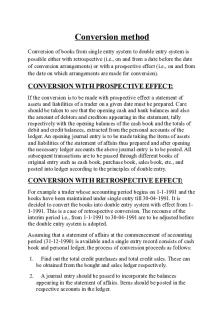Conversion efficiency PDF

| Title | Conversion efficiency |
|---|---|
| Course | The biology of survival |
| Institution | The Open University |
| Pages | 2 |
| File Size | 42.8 KB |
| File Type | |
| Total Downloads | 94 |
| Total Views | 188 |
Summary
Amazing Assignment Notes!...
Description
Conversion efficiency
In food chains, the ability of a consumer to convert biomass from a lower trophic level (its food) into body mass at its own trophic level determines how much energy is passed along the chain.
What becomes of the energy leaving the systems in products? It enters other systems where it will all eventually be released as heat. The milk is consumed by humans and respired, the volatile organic compounds are gradually oxidised in the atmosphere and the soil organic matter, which may store the energy for very many years (possibly millennia), will eventually be respired by microbial action, usually after a soil-disturbance event.
The biomass at the lowest trophic level is grass. Taking 1 ha of pasture, a typical quantity of new biomass produced in a year (NPP) is 7 tonnes, which represents around 60% of the total carbon fixed by the crop, the other 40% being used in respiration that supplied energy for the maintenance of plant tissues.
Not all of the NPP will be available for the cattle to eat: some of it will be below ground in the root system, some released as volatile organic compounds such as isoprene and some of the shoots will be avoided by the cattle such as where they have been soiled by faeces, and some leaves will wither and die before a cow gets to them. So of the 7 tonnes produced, only 3.4 tonnes is ingested by the grazers. The proportion of the food produced at the lower level that is ingested by the organism at the higher level is referred to as the consumption efficiency. In this case, the consumption efficiency of the cattle is (3.4/7) × 100 = 48%.
Once consumed, the grass needs to be digested in order for the cow to absorb its nutrients. Cows being ruminants are efficient at this process (compared with non-ruminants like horses.) They may be able to extract 50% of the energy stored in the grass. This proportion is known as the assimilation efficiency.
Finally, once the nutrients have been absorbed into the bloodstream of the cow, how much of it will be locked up in new tissue (meat)? This is very dependent on which stage of its life-cycle the cow is at. Young animals less than 2 years old will be relatively efficient at converting nutrients into meat, whilst adult cattle >3 years old will convert very little, if any, of their food to new tissue as they are already fully grown. All their energy goes to supply their basal metabolic rate, generating heat to keep warm, maintenance and repair of their tissues and movement. Only pregnant cows will be devoting substantial energy toward creation of new tissue. So taking the example of a year-old calf, its production efficiency might be just 3%, because the vast majority of the energy it assimilates is used in maintaining body temperature.
If the whole process is now considered, how much of the energy stored in the biomass at the lower trophic level is transferred to biomass at the upper level? The overall conversion efficiency is the product of the three proportions described above: Conversion efficiency = consumption efficiency × assimilation efficiency × production efficiency. In this case, using the calf as an example and using the same consumption and assimilation efficiencies for cows: Conversion efficiency = 0.48 × 0.5 × 0.03 = 0.007. Therefore less than 1% of the energy is being transferred up the chain. One percent is a typical value and demonstrates why organisms at higher trophic levels need vast areas to supply their energy. A tertiary consumer may only incorporate (0.01)3 of a system’s net primary productivity (NPP) into its tissues. Therefore. in order to gain 1 kg in mass, the tertiary consumer would need around 1000 tonnes of primary production to support it!...
Similar Free PDFs

Conversion efficiency
- 2 Pages

Efficiency of Distillation Column
- 129 Pages

rotary dryer efficiency project
- 24 Pages

Dynamic Efficiency
- 1 Pages

Lab 3 Detector Efficiency
- 4 Pages

Conversion sheet
- 1 Pages

1 - Efficiency Ratios
- 3 Pages

LAB40- Conversion
- 11 Pages

Conversion method
- 4 Pages

Conversion Factors
- 1 Pages

Conversion Chart
- 1 Pages

Tablas conversion
- 2 Pages
Popular Institutions
- Tinajero National High School - Annex
- Politeknik Caltex Riau
- Yokohama City University
- SGT University
- University of Al-Qadisiyah
- Divine Word College of Vigan
- Techniek College Rotterdam
- Universidade de Santiago
- Universiti Teknologi MARA Cawangan Johor Kampus Pasir Gudang
- Poltekkes Kemenkes Yogyakarta
- Baguio City National High School
- Colegio san marcos
- preparatoria uno
- Centro de Bachillerato Tecnológico Industrial y de Servicios No. 107
- Dalian Maritime University
- Quang Trung Secondary School
- Colegio Tecnológico en Informática
- Corporación Regional de Educación Superior
- Grupo CEDVA
- Dar Al Uloom University
- Centro de Estudios Preuniversitarios de la Universidad Nacional de Ingeniería
- 上智大学
- Aakash International School, Nuna Majara
- San Felipe Neri Catholic School
- Kang Chiao International School - New Taipei City
- Misamis Occidental National High School
- Institución Educativa Escuela Normal Juan Ladrilleros
- Kolehiyo ng Pantukan
- Batanes State College
- Instituto Continental
- Sekolah Menengah Kejuruan Kesehatan Kaltara (Tarakan)
- Colegio de La Inmaculada Concepcion - Cebu



